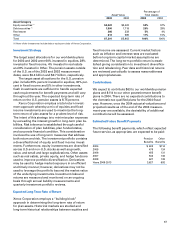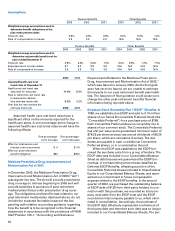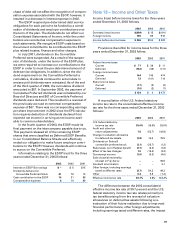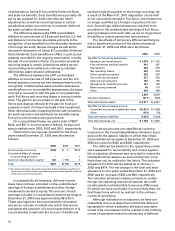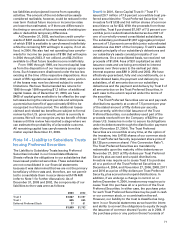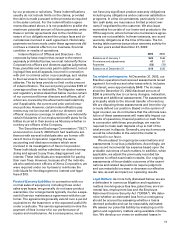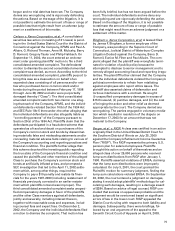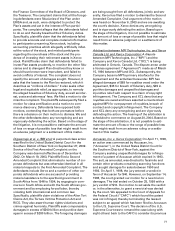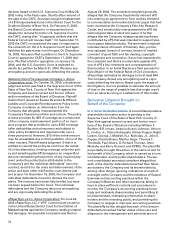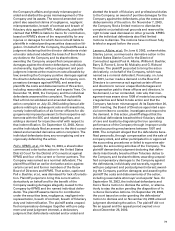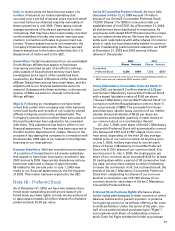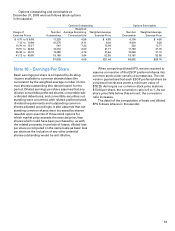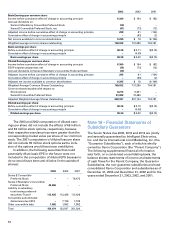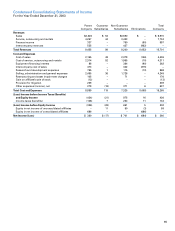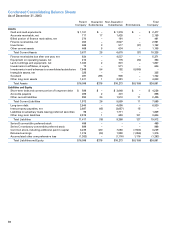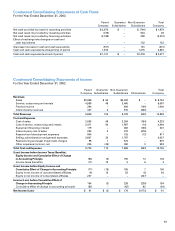Xerox 2003 Annual Report Download - page 79
Download and view the complete annual report
Please find page 79 of the 2003 Xerox annual report below. You can navigate through the pages in the report by either clicking on the pages listed below, or by using the keyword search tool below to find specific information within the annual report.
77
the Finance Committee of the Board of Directors, and
the Treasurer. The complaint claims that all the forego-
ing defendants were fiduciaries of the Plan under
ERISA and, as such, were obligated to protect the
Plan’s assets and act in the interest of Plan partici-
pants. The complaint alleges that the defendants failed
to do so and thereby breached their fiduciary duties.
Specifically, plaintiffs claim that the defendants failed
to provide accurate and complete material information
to participants concerning Xerox stock, including
accounting practices which allegedly artificially inflat-
ed the value of the stock, and misled participants
regarding the soundness of the stock and the pru-
dence of investing their retirement assets in Xerox
stock. Plaintiffs also claim that defendants failed to
invest Plan assets prudently, to monitor the other fidu-
ciaries and to disregard Plan directives they knew or
should have known were imprudent, and failed to
avoid conflicts of interest. The complaint does not
specify the amount of damages sought. However, it
asks that the losses to the Plan be restored, which it
describes as “millions of dollars.” It also seeks other
legal and equitable relief, as appropriate, to remedy
the alleged breaches of fiduciary duty, as well as inter-
est, costs and attorneys’ fees. We filed a motion to dis-
miss the complaint. The plaintiffs subsequently filed a
motion for class certification and a motion to com-
mence discovery. Defendants have opposed both
motions, contending that both are premature before
there is a decision on their motion to dismiss. We and
the other defendants deny any wrongdoing and are
vigorously defending the action. Based on the stage of
the litigation, it is not possible to estimate the amount
of loss or range of possible loss that might result from
an adverse judgment or a settlement of this matter.
Digwamaje et al. v. IBM et al: A purported class action
was filed in the United States District Court for the
Southern District of New York on September 27, 2002.
Service of the First Amended Complaint on the
Company was deemed effective as of December 6,
2002. On March 19, 2003, Plaintiffs filed a Second
Amended Complaint that eliminated a number of cor-
porate defendants but was otherwise identical in all
material respects to the First Amended Complaint. The
defendants include Xerox and a number of other cor-
porate defendants who are accused of providing
material assistance to the apartheid government in
South Africa from 1948 to 1994, by engaging in com-
merce in South Africa and with the South African gov-
ernment and by employing forced labor, thereby
violating both international and common law.
Specifically, plaintiffs claim violations of the Alien Tort
Claims Act, the Torture Victims Protection Act and
RICO. They also assert human rights violations and
crimes against humanity. Plaintiffs seek compensatory
damages in excess of $200 billion and punitive dam-
ages in excess of $200 billion. The foregoing damages
are being sought from all defendants, jointly and sev-
erally. Xerox has filed a motion to dismiss the Second
Amended Complaint. Oral argument of the motion
was heard on November 6, 2003 and we are awaiting
the court’s decision. Xerox denies any wrongdoing
and is vigorously defending the action. Based upon
the stage of the litigation, it is not possible to estimate
the amount of loss or range of possible loss that might
result from an adverse judgment or a settlement of
this matter.
Arbitration between MPI Technologies, Inc. and Xerox
Canada Ltd. and Xerox Corporation: A dispute
between MPI Technologies, Inc. (“MPI”) and the
Company and Xerox Canada Ltd. (“XCL”) is being
arbitrated in Ontario, Canada. The dispute arose under
a license agreement (“Agreement”) made as of March
15, 1994 between MPI and XCL. Subsequently, the
Company became MPI’s primary interface for the
Agreement and the activities thereunder. MPI has
alleged damages of $69 for royalties owed under the
Agreement, $35 for breach of fiduciary duty, $35 in
punitive damages and unspecified damages and
injunctive relief with respect to a claim of copyright
infringement. The Company and XCL deny that any
royalties are owed and have asserted a counterclaim
against MPI for overpayment of royalties, breach of
contract and copyright infringement. The Company
and XCL deny any wrongdoing and are vigorously
defending the action. The hearing of the arbitration is
scheduled to commence on August 20, 2004. Based on
the stage of the arbitration, it is not possible to esti-
mate the amount of loss or the range of possible loss
that might result from an adverse ruling or a settle-
ment of this matter.
Accuscan, Inc. v. Xerox Corporation: On April 11, 1996,
an action was commenced by Accuscan, Inc.
(“Accuscan”), in the United States District Court for
the Southern District of New York, against the
Company seeking unspecified damages for infringe-
ment of a patent of Accuscan which expired in 1993.
The suit, as amended, was directed to facsimile and
certain other products containing scanning functions
and sought damages for sales between 1990 and
1993. On April 1, 1998, the jury entered a verdict in
favor of Accuscan for $40. However, on September 14,
1998, the court granted our motion for a new trial on
damages. The trial ended on October 25, 1999 with a
jury verdict of $10. Our motion to set aside the verdict
or, in the alternative, to grant a new trial was denied
by the court. We appealed to the Court of Appeals for
the Federal Circuit (“CAFC”) which found the patent
was not infringed, thereby terminating the lawsuit
subject to an appeal which has been filed by Accuscan
to the U.S. Supreme Court. The decision of the U.S.
Supreme Court was to remand the case (along with
eight others) back to the CAFC to consider its previous


